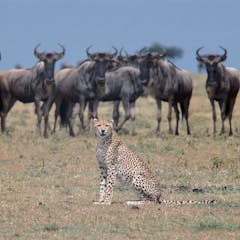
Articles on Predators
Displaying 1 - 20 of 122 articles

Whether people are hunters can have a big effect.

Not much is known about the predator fly Laphria saffrana. New research identified how they count the wingbeats of their favored prey, letting it slip out of focus before adjusting their heads.

We analysed photos of predators and prey from 3,667 camera traps in southwest Victoria. We found feral cats were more abundant and behaved differently in areas where foxes were baited.

We need every tool at our disposal to stop feral cats and foxes from decimating Australia’s incredible wildlife after fires. Artificial refuges show promise.

The welfare of wild animals is severely compromised to sustain grouse shooting in Scotland.

Understanding how animals think, learn and interact with one another can inform the science of ecology, as predator and prey shape their world.

It’s time to reconsider our relationship with the dingo. By collaborating and drawing from both Indigenous and Western knowledge, we can find ways to live in harmony with our apex land predator.

According to a new UN report, invasive species do more than US$423 billion in damage worldwide every year. Four articles explore examples, from mollusks to poisonous fish.

There’s shocking new evidence of rodenticide poisoning in Australia’s nocturnal predatory birds. High concentrations of the active ingredients were found in 92% of the 60 dead birds they tested.

Woylies bred in wildlife havens were smaller and less flighty than their counterparts in the wild. This could jeopardise the success of repopulation programs.

Dingoes are not wild dogs, research reveals. Most of the 307 wild animals sampled in this study were pure dingo. Australia’s apex predator deserves our respect after thousands of years on this land.

Reintroducing wolves can restore important ecological processes, but it can have unintended effects when smaller predators like coyotes are driven closer to people, a team of ecologists found.

Spiders liquefy their prey in order to consume it, and this makes it challenging to determine what spiders eat. A new approach that uses DNA barcoding is helping researchers figure out spider diets.

Shepherding livestock may be more effective protection than killing predators.

Researchers are analyzing the fossil cranium of a Smilodon fatalis that lived more than 13,000 years ago to learn more about the lifestyle of this iconic big cat.

For more than 200 years, European farmers have killed dingoes to protect livestock. But living alongside dingoes benefits nature - and actually helps graziers

False alarms are common in prey animals, but what causes them and how can they be avoided?

Less than a century ago, Colorado hunted, trapped and poisoned all the wolves within its borders. Today it’s restoring them – a change that reflects a profound shift in human thinking.

Developing countries suffer the most in the conflict between large carnivores and humans. We need better financial incentives for these communities to make sure these iconic predators are protected.

Rewilding is risky but we can learn from past attempts to use it as an effective tool for conservation
